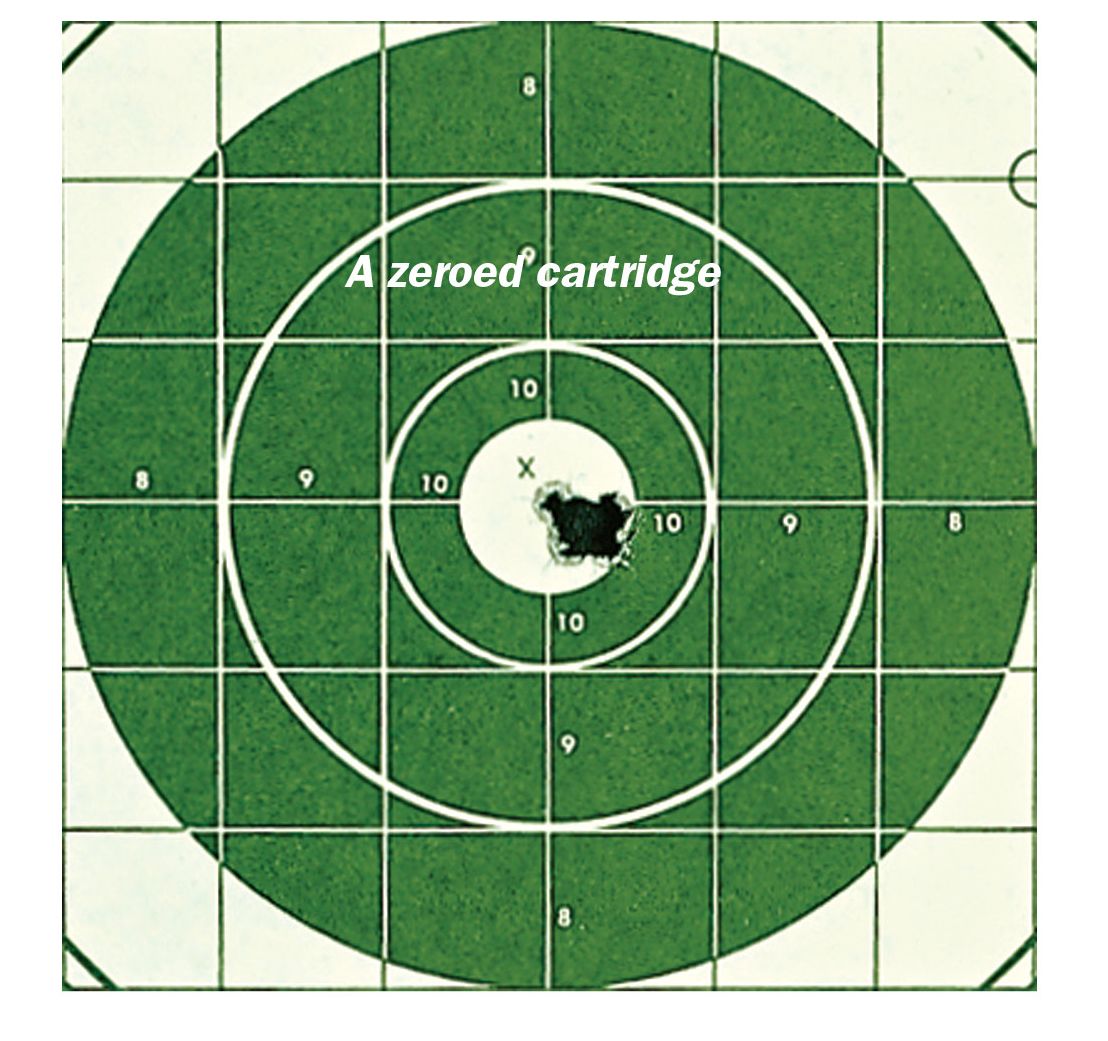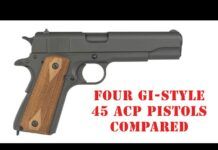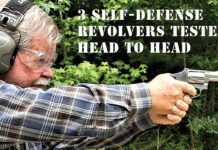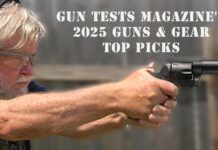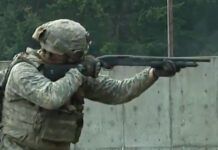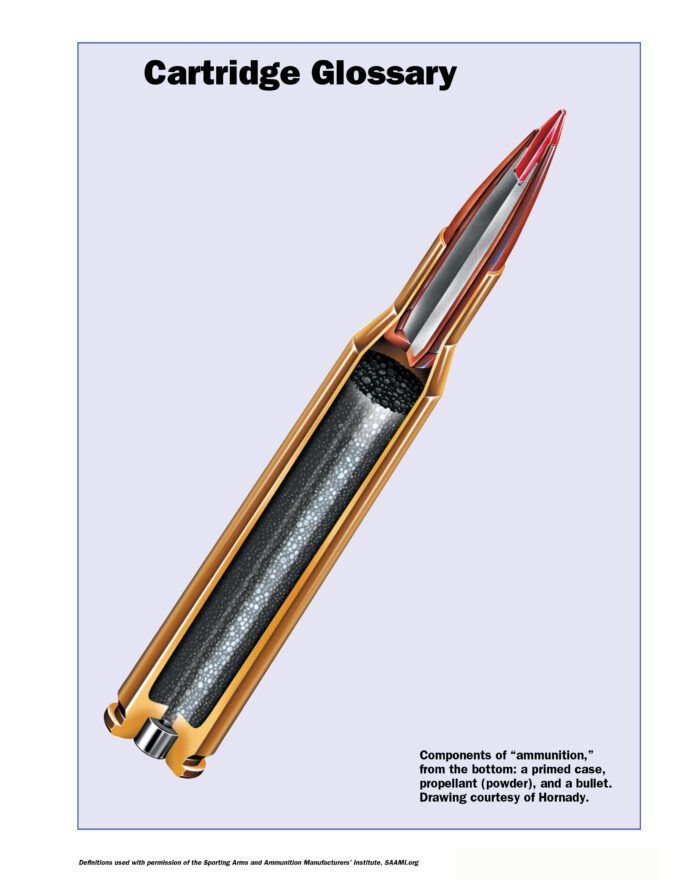A
Accidental Discharge (AD): An unexpected and undesirable discharge of a firearm.
Accuracy: A measurement of how widely dispersed a group of projectiles is.
Action: The combination of the receiver or frame and breech bolt together with the other parts of the mechanism by which a firearm is loaded, fired and unloaded.
Airgun: Uses compressed air or gas (carbon dioxide) to propel a projectile. Usually 17 to 22 caliber.
Air Space (Ullage): The volume in a loaded cartridge or shotshell not occupied by the propellant or the bullet, wads or shot.
Animal-Gut Cartridge: A primitive combustible cartridge consisting of a tubular sheath or sack filled with black powder. The sheath is made from thin, treated animal gut and is reasonably moisture proof.
Annular Ring: A circumferential crimp or indentation around the primer. In some military rounds, a dye was used in this ring for waterproofing and often to identify some characteristic of the cartridge.
Ammunition: Loaded cartridges consisting of a primed case, propellant and with or without one or more projectiles.
- In military parlance, small-arms ammunition have bores not larger than one inch.
- Ball ammunition means a cartridge with a full metal jacket or solid metal bullet.
- Live ammunition is an unfired cartridge or shotshell that is assembled with a live primer, propellant and projectile or shot charge.
- An ammunition lot is a term generally used by American sporting ammunition manufacturers for denoting same-day conditions used to load a batch of ammunition.
- Match ammunition is made specifically for match target shooting using special controls to assure uniformity.
- Metallic ammunition generally describes rimfire and centerfire ammunition.
- Reference ammunition is used in test ranges to evaluate test barrels, ranges and other velocity and pressure measuring equipment.
- Patched ball ammunition refers to a full metal jacketed bullet (FMJ).
- Tracer ammunition contains a compound in its base that burns during flight.
Annulus: The ring-like space between the top of the primer and the primer pocket or battery cup on the base of a cartridge. Colored lacquer is sometimes applied to this area to provide a visual seal.
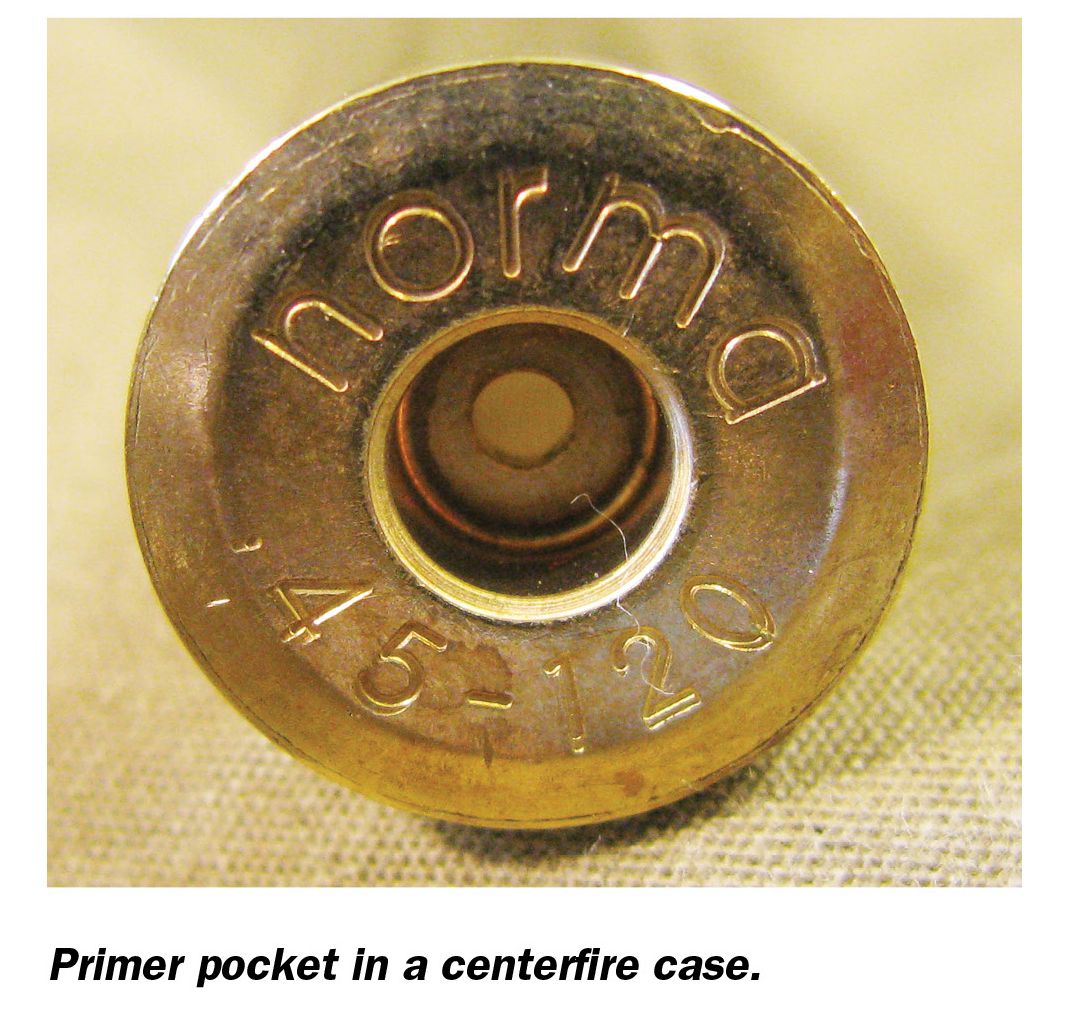
Antimony: A metallic element used to alloy lead to increase hardness.
Anvil: An internal metal component in a cartridge primer assembly against which the priming mixture is pinched by the firing-pin blow.
Armor Piercing (Ammunition): Ammunition utilizing a projectile specifically designed to penetrate hardened, or armor-plated targets such as tanks, trucks, and other vehicles.
Attached Head: Early centerfire with the head of the cartridge attached to the body by riveting or other means. Circa 1860s and beyond. Example: .577 Snider.
Auto: Shorthand for autoloader or automatic firearm operation.
B
Back Bore: A shotgun, chambered for a specified gauge, whose barrel bore diameter is greater than the nominal specified for that gauge, but does not exceed SAAMI maximum.
Backthrust: The force exerted on the breech block by the head of the cartridge case during propellant burning.
Ballistic Coefficient: An index of the manner in which a particular projectile decelerates in free flight.
Ballistics: The science of projectiles in motion. Interior Ballistics deal with projectile movement inside the gun. Includes all aspects of combustion within the gun barrel, including pressure development and motion of the projectile along the bore of the firearm. Exterior Ballistics study projectile movement between the muzzle and the target. Terminal Ballistics are effects of the projectile in the target.
Barrel Length (interior ballistics): Measurement from the face of the muzzle to the base of the seated bullet or base of the case neck.
Barrel Vibration: Oscillations of a barrel as a result of firing. Barrel whip is the movement of the muzzle end that occurs as the projectile leaves.
Battery Cup: In a shotshell primer, the flanged metallic cup that contains and supports the primer cup and anvil.
BB: Spherical shot having a diameter of .180 in. used in shotshell loads. The term BB is also used to designate steel or lead air rifle shot of .175 in. diameter.
Big Bore: Centerfire cartridge with a bullet .30 in. or larger in diameter.
Body: The cartridge case part which contains propellant, or the tubular section of a shotshell that contains the propellant, wads and shot charge.
Bore: The interior of a barrel forward of the chamber. Bore axis describes line through the center of the bore. Bore constriction means a reduction in the internal diameter of a firearm bore. Bore diameter in rifled barrels describes the minor interior diameter of a barrel, which is the diameter of a circle formed by the tops of the lands. Bore diameter in shotguns or muskets is the interior dimension of the barrel forward of the chamber but before any restrictive choke or expanded muzzle.
Bore Casting: Pouring a special alloy or material that has a low melting point into the bore or chamber of a firearm. The cast is used to study physical characteristics of the bore.
Bore Slugging: A process of determining the interior dimensions of a rifled barrel by measuring a lead ball which has been expanded to fill the bore.
Breech: The rear end of the barrel. A breech block is the mechanism that supports the head of the cartridge. The breech face is part of the breech block that rests against the head of the cartridge case or shotshell during feeding and firing. There are four major breeching systems. In the belted chamber design, the cartridge seats in the chamber on an enlarged band ahead of the extractor groove of the cartridge body. The mouth chamber design has the cartridge seated in the chamber on the mouth of the cartridge case. The rimless chamber seats the cartridge on the shoulder of the cartridge case. And in a rimmed chamber design, the cartridge seats in the chamber on the rim or flange of the cartridge case.
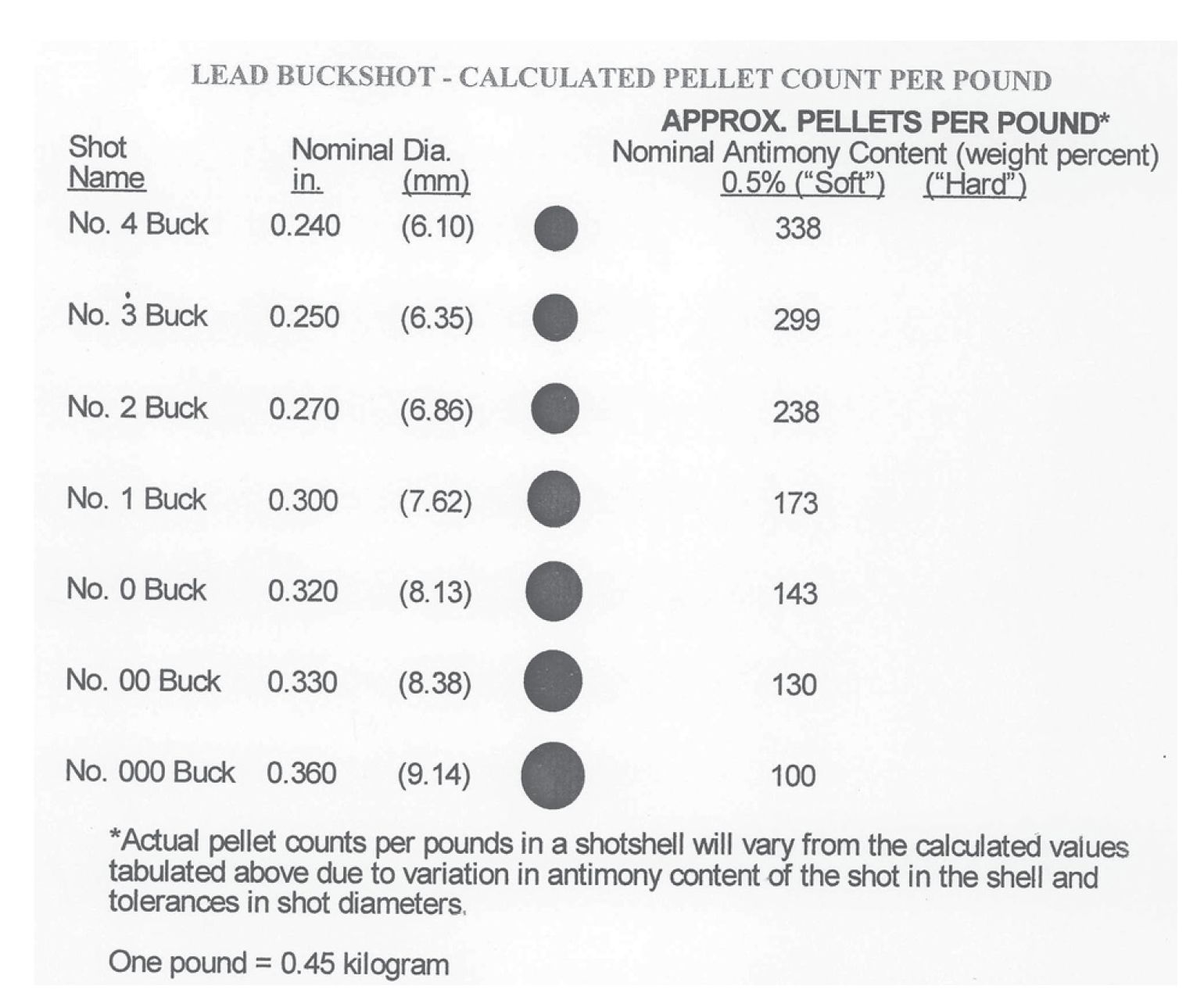
Buckshot: Lead pellets ranging in size from .20 to .36 in. diameter, normally loaded in shotshells.
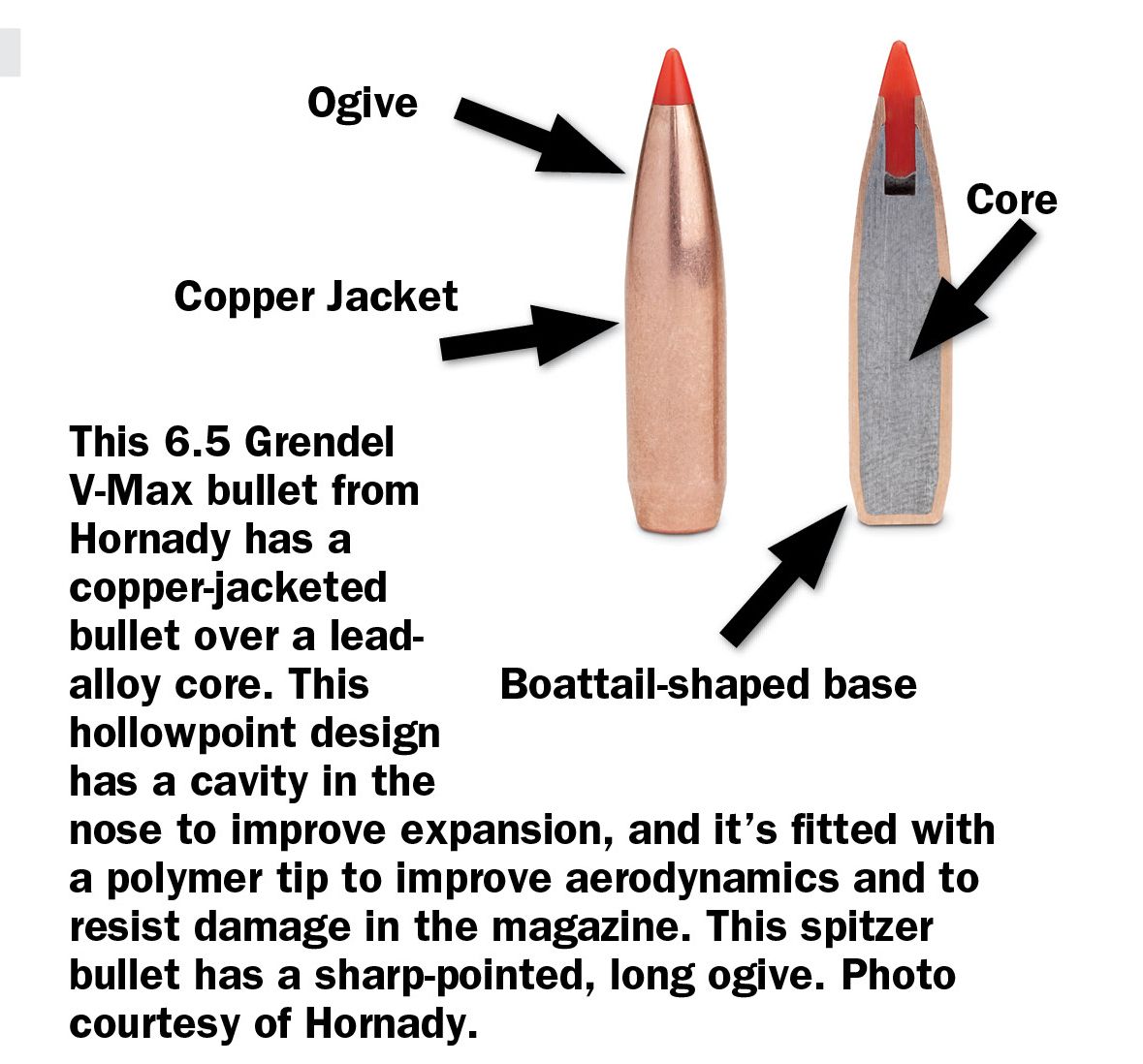
Bullet: A non-spherical projectile for use in a rifled barrel.
- Bullet jacket is the metallic cover over the core of the bullet.
- Bullet cores are usually an alloy of lead, antimony and/or tin.
- Bullet diameter is the maximum dimension across the largest cylindrical section of a bullet.
- A boattail bullet has a tapered or truncated conical base.
- A capped bullet uses a standard lead bullet with a harder-metal nose.
- A copper-jacketed bullet has an outer jacket of copper or copper alloy over a lead-alloy core.
- An expanding bullet is used for hunting, providing controlled expansion upon impact.
- An exploding bullet contains an explosive in the nose, intended to explode on impact.
- A flat-nose bullet has a flattened front end at right angles to the axis.
- A frangible bullet is designed to break up upon impact to minimize ricochet or spatter.
- A full-metal-jacket (FMJ) bullet encloses most of the core, with the exception of the base, with another metal.
- A hollowpoint bullet has a cavity in the nose to improve expansion.
- The bullet ogive is the curved forward part of a bullet.
- A partition bullet has a jacket divided into two cavities, which enclose the forward and rear cores of the bullet. It is designed so the first cavity expands and the rear cavity holds together for penetration.
- A roundnose bullet has a radiused nose.
- A semi-jacketed bullet has a partial jacket that exposes a lead nose.
- Similarly, a semi-jacketed hollowpoint bullet has a partial jacket and the lead nose has a cavity.
- A semi-wadcutter bullet (SWC) employs a distinct shoulder and short truncated cone at the forward end. The conical extended nose, flat point, and sharp shoulder cut a full-diameter hole in the target. May also include a hollowpoint to facilitate expansion.
- Soft-point bullets (SP) expose a portion of the core at the nose of a jacketed bullet. Often abbreviated JSP or SP. They tend to expand more slowly than a hollowpoint bullet and are used where deeper penetration and expansion are needed.
- A spire-point bullet has a cone-shaped ogive. A spitzer bullet has a sharp-pointed, long ogive. From the German word spitz, meaning pointed. Most modern military bullets are of this type.
- A steel-jacket bullet uses plated or clad steel in place of gilding metal or copper. A swaged bullet is formed by ramming the bullet material into a die.
- A truncated bullet is a flat-nosed bullet design with a conical shape rather than a nose formed by a radius. The truncated-cone design uses a flat-nosed bullet with a conical shape rather than ogive formed by a curve or radius.
- A wadcutter bullet has a sharp-shouldered nose intended to cut target paper cleanly.
- A wax bullet is made from paraffin or other wax material, usually for short-range indoor-target shooting.
- A heel-type bullet has a rear section of reduced diameter; so when loaded, the front portion is flush with the case. Sintered bullets are formed by the high-pressure consolidation of powdered metal into a bullet form. Such bullets were made experimentally and loaded into .30-06 cases prior to WWII also adopted by Germany in 9mm during the war.
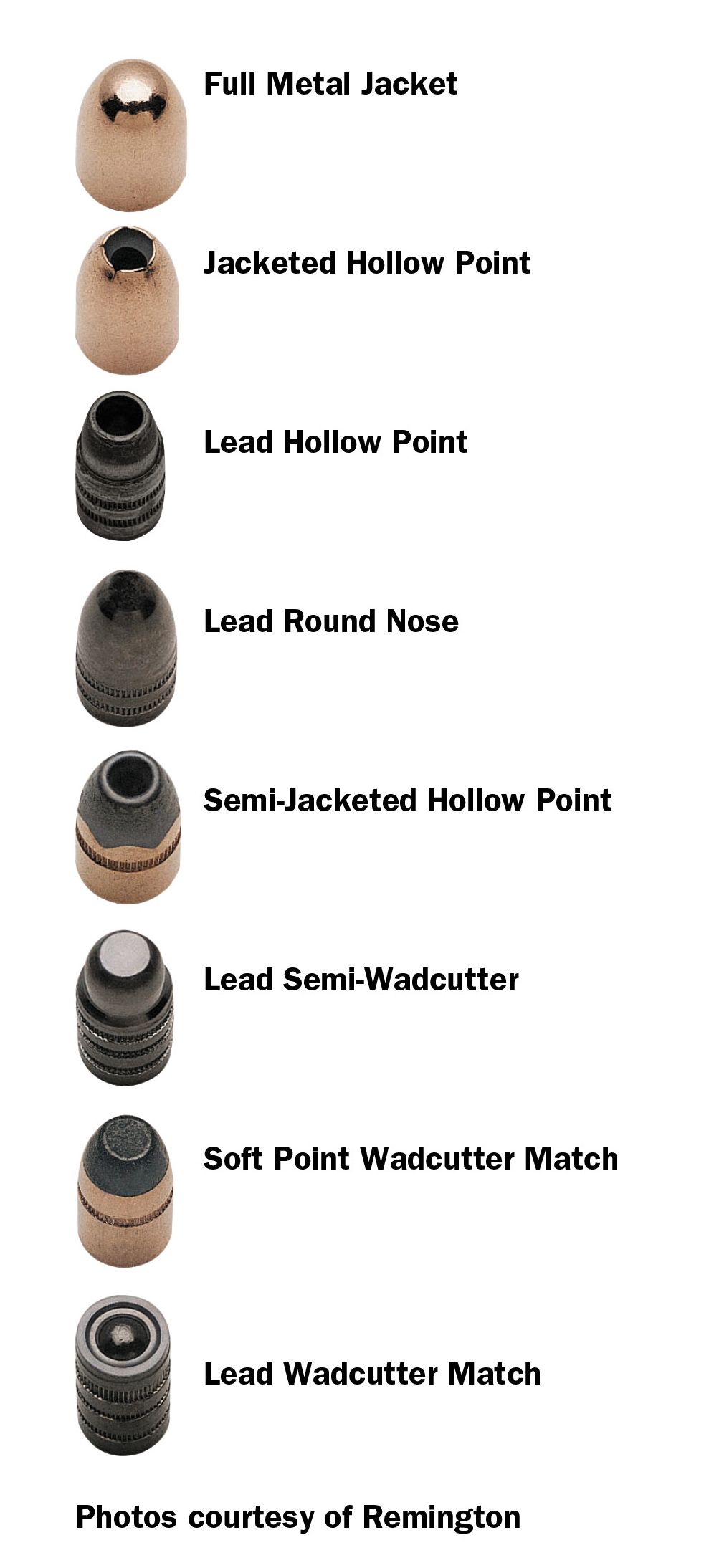
Bullet Jump: The distance a bullet must travel from the cartridge case to the rifling.
Bullet Upset: In interior ballistics, the change of bullet form due to chamber pressure. In exterior ballistics, the expansion of a bullet upon impact.
Bulk Density: The ratio of the weight of a given volume of powder versus the weight of the same volume of water.
Burning Rate (Burn Rate): An index of how fast burning propellant changes into gas.
C
Caliber: The approximate diameter of the circle formed by the tops of the lands of a rifled barrel, often expressed in hundredths of an inch or millimeters.
Cannelure: A circumferential groove generally of corrugated appearance cut or impressed into a bullet or cartridge case.
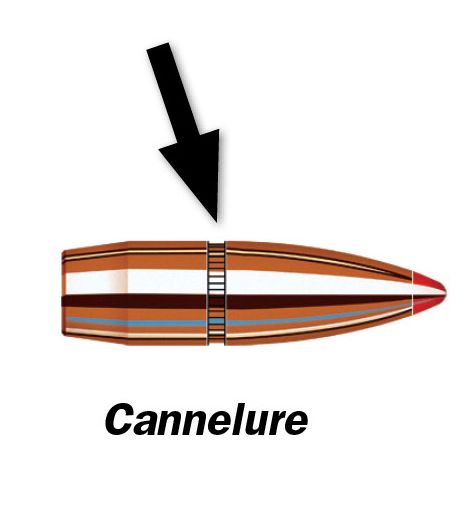
Cartouche: French equivalent for cartridge.
Cartridge: A single round of ammunition consisting of the case, primer and propellant with or without one or more projectiles. Also applies to a shotshell.
- The cartridge case is the main body of a single round into which other components are inserted to form a cartridge. Usually made of brass, steel, copper, aluminum or plastic.
- Wildcat is a nonstandard cartridge usually based upon modifications of an existing commercial cartridge case.
- A bottleneck cartridge has a distinct angular shoulder stepping down to a smaller diameter at the neck.
- A centerfire cartridge has its primer central to the axis in the head of the case.
- Metric cartridges are identified by their nominal bullet diameter and cartridge case length, both of which are given in millimeters, such as 7×57.
- A rimfire cartridge is a flange-headed piece containing the priming mixture inside the rim cavity, aka smallbore.
- Rimless cartridge’s case head is the same diameter as the body.
- Rimmed cartridges have a rimmed or flanged head larger in diameter than the body of the case.
- Semi-rimmed means the case head is slightly larger in diameter than the case body and has an extractor groove forward of the head.
- A flechette cartridge is loaded with one or multiple finned steel dartlike projectiles.
- A Flobert cartridge is a small-caliber (9mm or smaller) rimfire cartridge, usually used for indoor shooting in Europe. Many contain only primer compound. Caseless cartridges are modern designs wherein the “case” is molded solid propellant with an attached projectile and primer and is consumed in firing.
- Combustible cartridges were early ammunition which contained propellant in a nitrated paper casing. The entire envelope was consumed when the round was fired.
Cartridge Neck: Reduced-diameter cylindrical portion of a cartridge case, extending from the bottom of the shoulder to the case mouth.
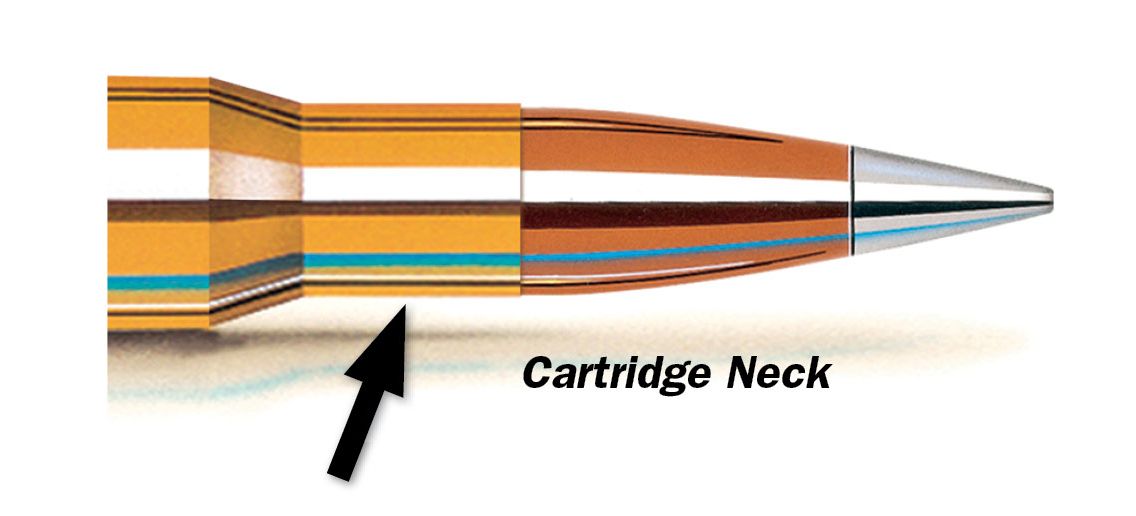
Case: aka cartridge case or shotshell case. A belted case has an enlarged band ahead of the extractor groove, common on magnum-type cartridges. A straight case has little or no taper along its length. A solid-drawn case is formed from a metallic disc that has been subjected to an alternating series of progressive draws and anneals, resulting in a finished cartridge case. Solid-head cases are modern construction where the head is formed from comparatively thick metal to withstand the higher pressures of modern loads. Folded-head cases have their bases folded to form the rim and primer pocket.
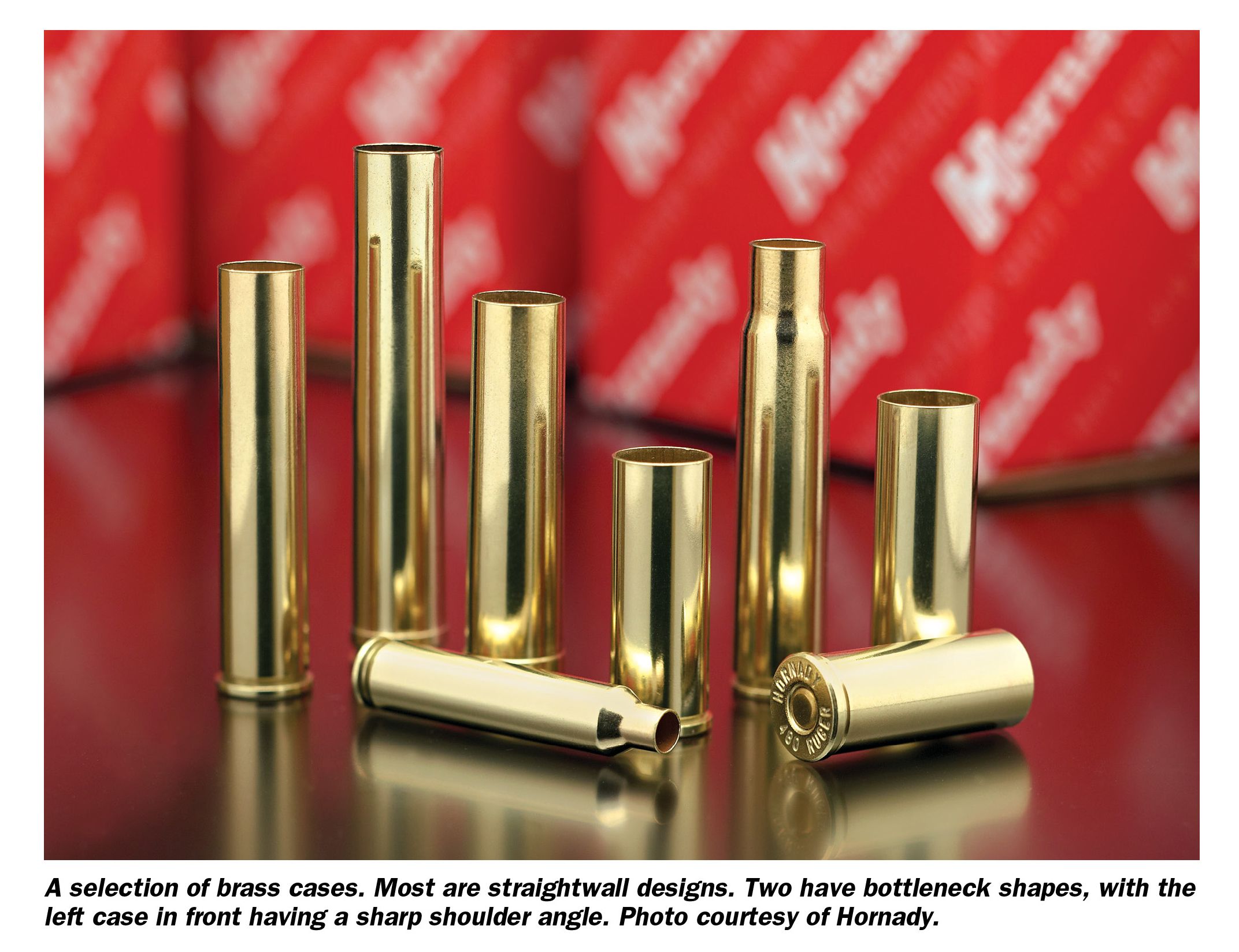
Case Capacity: How much propellant will fit in a cartridge case with a fully seated bullet.
Case Extractor Groove: An annular groove cut in rimless, semi-rimmed cartridge or belted cases, forward of the head, for the purpose of providing a surface that the gun extractor may grip to remove the case from the chamber. Also called cannelure.
Case Fire-Forming: Changing the external shape of a cartridge case by firing in a chamber of the desired configuration.
Case Head Expansion: An enlargement of the cartridge case head diameter on firing.
Case Mouth: The opening in the case into which the projectile or shot is inserted.
Case Shoulder: The angled or tapered section of a bottleneck cartridge case connecting the main body of the case to the smaller-diameter neck.
Case Split: A longitudinal rupture in the wall of a cartridge case or shotshell.
Case Stretching: The elongation in the body of a cartridge case during firing.
Case Taper: The gradual reduction in diameter of a cartridge case from head to shoulder or mouth.
Casting: A process for making lead bullets by pouring molten metal into a mold.
Chamber: In a rifle, shotgun or pistol, the rearmost part of the barrel that has been formed to accept a specific cartridge or shell when inserted, or the holes in the cylinder of a revolver. Chamber leade is the conical part of the bore between the chamber and the rifling.
Coefficient Of Form: A numerical term indicating the general profile of a projectile.
Cook-Off: High temperatures in a firearms chamber (usually machine guns) causing firing of a cartridge without operation of the firing mechanism.
Copper Units of Pressure (CUP): Measurement of pressure using a piston fitted into a hole drilled in the chamber. Upon ignition, gases drive the piston into a calibrated copper slug. The amount of calibrated deformation is then checked on standardized tables, which give resulting pressures. Piezoelectric and strain-gauge measurements (PSI) have largely replaced CUP.
Copper Wash: A copper coating applied to a steel cartridge case for corrosion resistance.
Copper-Tubed Bullet: A lead hollowpoint bullet with a thin, closed-ended copper tube. Also called express bullet.
Cordite: A type of smokeless nitrocellulose powder. Used widely in British military and sporting cartridges.
Crimp: The closure of the mouth of a shotshell. A rolled crimp is performed by inverting the mouth of the tube over a top wad or slug. A star crimp, aka rose crimp, folds the sidewalls in a star-shaped pattern. A stake crimp is a rectangular crimp on the case neck or primer pocket. Stab crimps appear on the neck as a point or dot. Also called point crimp.
Crispin Cartridge: Rimfire cartridge where the fulminate is contained in an annular ring nearly midway between the base and mouth of the cartridge.
Cupfire Cartridge: A front-loading rimfire cartridge used in early pistols.
Cutaway Cartridge: A sectioned cartridge that shows interior construction.
Cylinder Gap: The opening or clearance between barrel and cylinder in a revolver.
D
Decapper: Tool used to remove primers from cartridge cases or shells.
Doubling: Unintentional firing of a second shot.
Double-Tap: Two very quick shots fired from a handgun with both directed by the sights.
Dram Equivalent (Dram Equiv): The accepted method of correlating relative velocities of shotshells loaded with smokeless propellant to shotshells loaded with blackpowder. The reference blackpowder load chosen was a 3-dram charge of blackpowder, with 11⁄8 oz. shot and a velocity of 1200 fps. Therefore, a 3-dram equivalent load using smokeless powder would be with 11⁄8 oz. of shot having a velocity of 1200 fps or 1.25 oz. of shot and a velocity of 1165 fps. A 31⁄4-dram-equivalent load might have 11⁄8 oz. shot and a velocity of 1255 fps.
Draw Mark: A longitudinal scratch on a cartridge case caused by foreign material on either the draw punch or die during fabrication.
Drop Test (Sensitivity Test For Primed Shells Or Primers): A method of determining the sensitivity of primed cases held in a specified die and subjected to a range of specified firing-pin blows imparted by a freely falling ball.
Dud: A popular term for a cartridge that fails to fire after its primer is struck by the firearm’s firing pin.
Dum-Dum Bullet: Often misused as a term for any soft-nosed or hollowpoint hunting bullet. Derives from a British .303 cal. military bullet developed in India’s Dum-Dum Arsenal circa 1897-1898.
E F
Engraving: 1. The grooves cut into a bullet by barrel rifling. 2. The forming of grooves in a bullet by the barrel rifling.
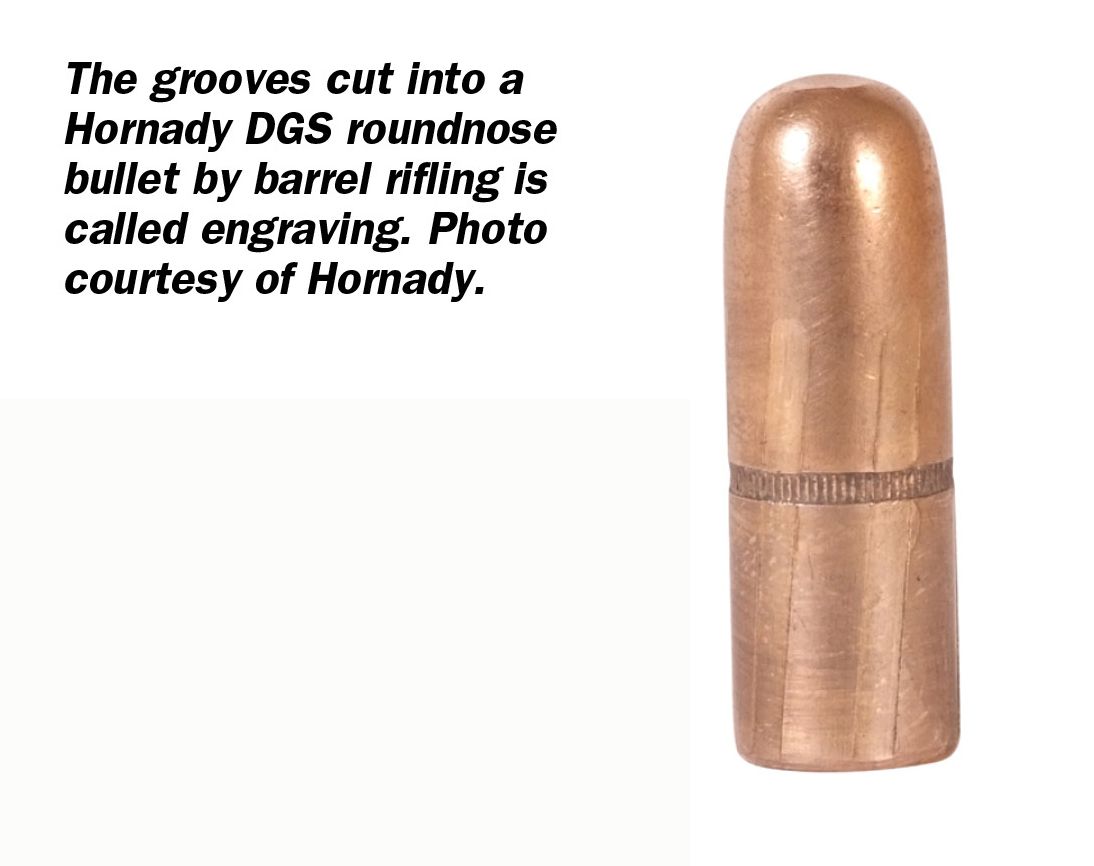
Energy: The following formula is used to obtain kinetic energy of a projectile: E = WV2/14,000gc where: W = weight of projectile, in grains V = velocity, in feet per second gc = gravitational constant, 32.16 feet/second squared. Commonly expressed in the foot-pounds, joules or kilogram meters.
Extreme Spread: The distance between the centers of the two shots which are the farthest apart of a group of shots on a target.
Forcing Cone: The tapered lead from the shotgun chamber diameter to the bore diameter. The tapered lead from the bore diameter to the choke diameter. The tapered entrance to the bore in the rear of a revolver barrel.
Feed Throat: A component which guides a cartridge from the magazine to the chamber.
Flash Hole: A hole pierced or drilled through the center of the web in the primer pocket in a metallic cartridge case. The hole in the end of a battery cup primer used in shotshells.
Flash Suppressant: A material that is added to propellant for the purpose of reducing muzzle flash.
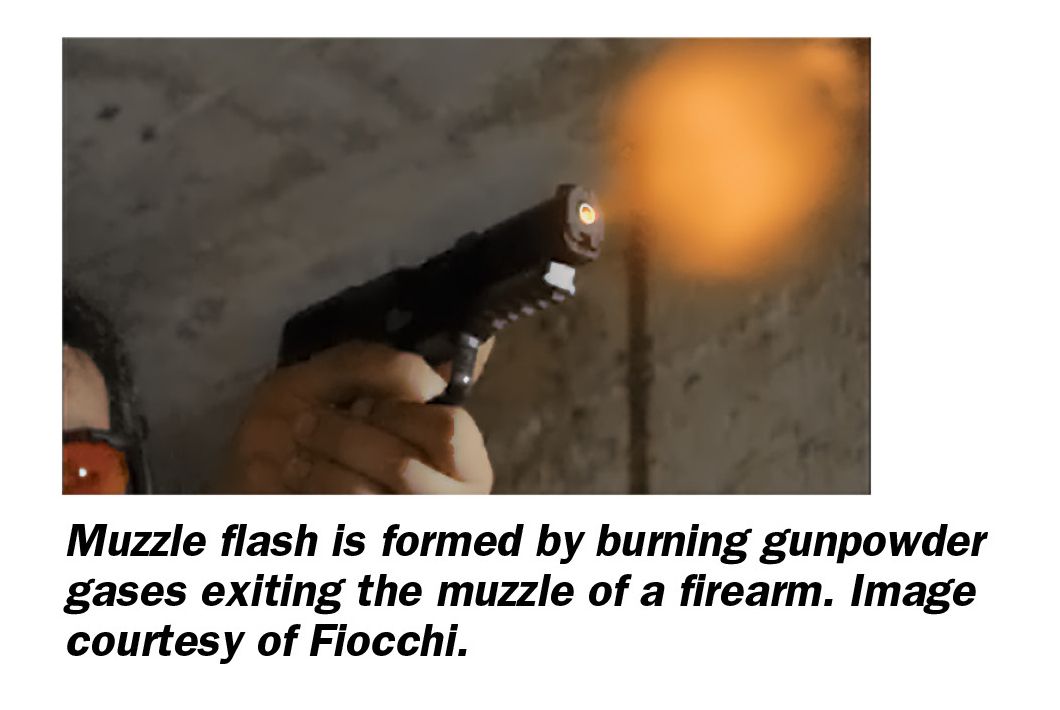
Foil: Part of a primer.
Frangible Projectile: A projectile that breaks up readily upon impact.
Free Bore: A cylindrical length of bore in a firearm just forward of the chamber in which rifling is not present. Associated with bullet jump.
Full-Length Resizing: The operation of reforming a fired cartridge case to approximately its original dimensions.
Fusing: The balling of lead shot due to gas leakage. The melting of the core of a jacketed bullet. The melting of a lead alloy bullet.
G
Gunpowder (Powder, Blackpowder, Semi-Smokeless, Pseudo Blackpowder, Smokeless):
- Blackpowder is a finely ground mixture of about 15% charcoal, 10% sulfur, and 75% potassium nitrate. Proportions vary. Undoubtedly known to early Chinese and Hindu people of India as an incendiary or a demolition device and not in “firearms.” Earliest known use of it as propellant in firearms was by the Arabs, circa 1150, in their war with the Iberians. Blackpowder is classified as an explosive. It is characteristically graded by grain size such as Fg (coarse) or FFFFG (fine). It generates low pressures in gun chambers.
- Semi-Smokeless Powder appeared in the late 1800s and early 1900s. It was a mixture of blackpowder and gun cotton (nitrocellulose). Hazardous. Discontinued in the late 1940s. Pseudo Blackpowder: Pyrodex and similar products are modern substitutes for blackpowder. Classified as a flammable solid, not as an explosive. In firearms, Pyrodex can be substituted volume-for-volume for blackpowder charges.
- Smokeless powder contains mainly nitrocellulose (single base) or both nitrocellulose and nitroglycerine (double base).
- Single-Base Powder: a smokeless propellant for ammunition whose principal ingredient is colloided nitrocellulose. The nitrogen content of the nitrocellulose is usually between 13.1% and 13.2%.
- Double-Base Smokeless Powder: A propellant composed of colloided nitrocellulose and nitroglycerin as its base as opposed to single-base powder, which has colloided nitrocellulose only as its base material. The percentage of nitroglycerin added ranges from a low of 3% to a high of 39%. Made of a nitrocellulose base (single-base powders typified by the Improved Military Rifle Powder, IMR, types) or a nitrocellulose and nitroglycerine mix (double-base, such as Bullseye). Triple-base powders incorporate nitroguanidine and similar ingredients, but are not in wide commercial distribution. Generally used in large caliber military ammunition.
- Modern powders are available in tubular grains, spherical grains, and flakes. The grains of modern smokeless propellant powders are made in various sizes. The smaller the grain, the faster it burns. Flake powder is a type of smokeless propellant in the form of thin discs or cut squares. Non-Hygroscopic smokeless powder resists water absorption. Progressive burning powder is a smokeless propellant in which the burning rate is controlled by physical and/or chemical means.
Gas Check: A metallic cup attached to the base of some lead alloy bullets. An obturating cup used under the piston in crusher pressure testing.
Gas Cutting: An erosive effect in a firearm caused by the high-velocity, high-temperature propellant gases.
Gauge: A term used in the identification of most shotgun bores. (410 bore is an exception.) It is related to the number of bore diameter lead balls weighing one pound.
Gilding Metal: Alloys of 90 or 95 percent copper and the remainder zinc. Also termed Commercial Bronze. Neither name is recommended by Copper Development Association, Inc., instead Alloy No. 220 and Alloy No. 210, respectively, are recommended. Used extensively for the manufacture of bullet jackets.
Grain: A unit of weight (avoirdupois), 7000 grains per pound. A term sometimes applied to a single particle of propellant powder. More properly called a kernel.
Gun Cotton: Nitrated cellulose (either cotton linters, wood pulp or a mixture of the two), which is used for the manufacture of smokeless propellant. Chemical name is nitrocellulose.
H
Hardball: A slang term for Full Metal Jacketed pistol ammunition with no lead exposed at the tip.
Head: The end of the cartridge case in which the primer or priming is inserted and the surface upon which the headstamp identification is imprinted.
Head Clearance: The distance between the head of a fully seated cartridge or shell and the face of the breech bolt when the action is in the closed position. Commonly confused with headspace. Headspace is the distance from the face of the closed breech of a firearm to the surface in the chamber on which the cartridge case seats.
Headstamp: Numerals, letters and symbols (or combinations) stamped into the head of a cartridge case or shotshell to identify the manufacturer, caliber or gage, and other additional information.
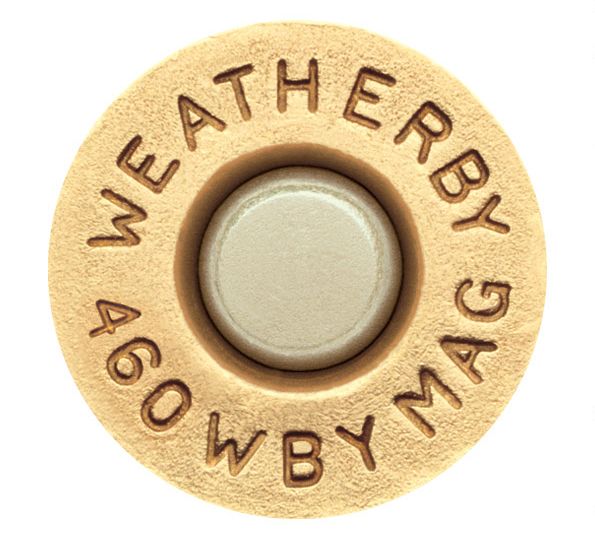
High Brass: Properly called “high cup,” this slang refers to the length of the external metal cup on a shotshell. The brass head extends approximately three-quarters of an inch up the case measured from the base of the head. The brass head on low brass (low cup) shotshells extends about one-quarter inch or less up the case from the base.
Heel: The rear portion of a bullet. A heel cavity is a recess in the base of a bullet.
Hull: Slang term for a cartridge or shotshell case.
J K L
Jacket: The envelope enclosing the lead core of a compound bullet.
Kernel: A single particle of propellant powder.
Keyhole: An oblong or oval hole in a target that is produced by an unstable bullet striking the target at an angle to the bullet’s longitudinal axis.
Lacquered Case: Usually a steel case which has been coated with lacquer for corrosion protection. Often, German WWII or Soviet bloc military rounds. Includes waterproofing technique for shotshells.
Loading Density: The ratio of the weight of the powder charge to the capacity of the case. It is usually expressed as the ratio of the charge weight to the capacity the powder chamber in grains of water.
Land(s): Uncut surface of the bore of a rifled barrel.
Lapping: The process of polishing a metal surface such as the interior of a barrel with a fine abrasive substance.
Leade: That section of the bore of a rifled gun barrel located immediately ahead of the chamber in which the rifling is conically removed to provide clearance for the seated bullet. Also called throat.
Leading: The accumulation of lead in the bore of a firearm from the passage of lead shot or bullets. Also, metal fouling.
Load: The combination of components used to assemble a cartridge or shotshell.
Loading Density: The relationship, in a cartridge, of the volume of the propellant to the available case volume. Usually expressed as a percentage.
Long Rifle: Originally, the term was used in reference to long-barreled flintlock rifles. Now, the name given one type of a caliber 22 rimfire cartridge.
Loose Pack: Cartridges provided loosely packaged in cartons rather than being tightly organized.
M
Magnum: A term commonly used to describe a rimfire or centerfire cartridge, or shotshell, that is larger, contains more shot or produces higher velocity than standard cartridges or shells of a given caliber or gauge.
Meplat: A term for the blunt tip of a bullet, specifically the tip’s diameter.
Mercurial: Refers to a primer composition containing a mercury compound. Non-mercurial primers are desired because traces of mercury in a fired cartridge case make it brittle and less useful for reloading.
Minie Ball: A conical-nosed lead bullet, slightly under bore diameter, incorporating a hollow base, designed to expand into the rifled bore upon firing for gas sealing purposes without the use of a patch.
Minute of Angle (M.O.A.): An angular measurement method used to describe accuracy capability. A minute of angle is one sixtieth of a degree, and subtends 1.047 inches at 100 yards, which for practical shooting purposes is considered to be one inch. A minute-of-angle group, therefore, equals 1 inch at 100 yards, 2 inches at 200 yards, etc.
Misfire: A failure of the priming mixture to be initiated after the primer has been struck an adequate blow by a firing-pin or the failure of the initiated primer to ignite the powder.
Mushroom: A descriptive term for a soft point, hollow point or special type of bullet point that is designed to expand to increased sectional diameter.
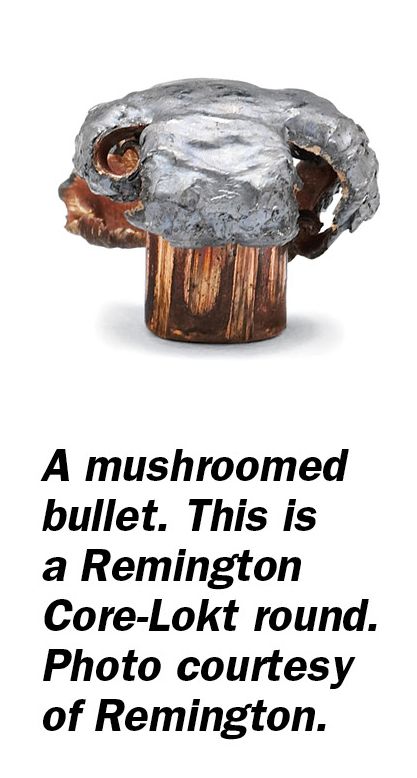
N O
Neck Annealing: A heating process used in cartridge case manufacture intended to relieve internal stresses in the neck area caused by cold working.
Neck Clearance: The dimensional difference between the diameter of the neck of a loaded cartridge case and the chamber.
Neck Radius: The curved surface between the neck and the shoulder of a cartridge case.
Neck Tension: The circumferential stress that the case neck exerts on the seated bullet, as a result of the interference fit provided by the case neck inside diameter and the bullet outside diameter.
Neck Thickness: Average thickness of the wall of a cartridge case surrounding the bullet.
Necking-Down: The use of case-forming dies to reduce both the outside and inside diameter of a cartridge case neck.
Non-Corrosive: A term applied to primers that contain no chemical compounds that could produce corrosion or rust in gun barrels, but does not necessarily protect from corrosion or rust.
Nose: The point or tip of a bullet.
Obturation: The momentary expansion of a cartridge case against chamber walls, which minimizes the rearward flow of gases between the case and the chamber wall when the cartridge is fired.
Ogive: The curved portion of a bullet forward of the bearing surface.
Oilproof: The treatment of a cartridge to minimize the entry of oil or water.
Overall Length: The greatest dimension of a loaded cartridge, i.e., from face of the head to the tip of the bullet for centerfire or rimfire or to the crimp for shotshells.
P
Paper Shell: Shotshells which are constructed with a body made from paper tubing.
Parabellum: The pistol, and especially the 9×19 mm cartridge for it, designed by George Luger and adopted by the German army in 1908.
Patched Ball (Muzzleloading): Round or conical lead projectiles that utilize cloth or other material to form a gas seal for the projectile.
PSI: Pounds per square inch.
Powder Chamber Capacity: As with most interior ballistics capacity measurements it is usually expressed in grains of water. It is determined by measuring the weight of water that a fired case from the test firearm can contain with a bullet seated to its normal depth. Note that this varies with different bullets or seating depth as well as the dimensions of the chamber, and the brand of case.
Percussion: A means of ignition of a propellant charge by a mechanical blow against the primer (modern) or cap (antique). A percussion cap is the ignition source for several types of muzzleloading firearms, usually consisting of a copper alloy cup containing the priming mix. It is placed on the nipple.
Pitch (Rifling): The distance a bullet must travel in the bore to make one revolution.
Point-Blank Range: The farthest distance that a target of a given size can be hit without holding over or under with the sights.
Powder Burning Rate: The speed with which a propellant burns. It is affected by both physical and chemical characteristics, as well as conditions under which it is burned.
Powder Charge: The amount of powder by weight in a cartridge case.
Powder Deterioration (Smokeless): The chemical decomposition of modern smokeless propellant. It can be accelerated by improper storage conditions.
Powder Fouling: Powder residue left in firearms after firing.
Powder Measure: A device to measure quantities of powder volumetrically.
Pressure: In a gun or cartridge, the force imparted to various components that is developed by the expanding gases generated by the deflagration of the propellant when fired.
Primer: A cartridge ignition component consisting of brass or gilding metal cup, priming mixture, anvil and foil disc, which fires the cartridge when struck with sufficient force.
- The primer cup is a brass or copper cup designed to contain priming mixture.
- Primer pellet is the explosive component of a primer.
- The primer pocket is a cylindrical cavity formed in the head of a metallic centerfire cartridge case, or in the head of a shotshell, to receive an appropriate primer or battery cup primer assembly.
- Boxer primers are an ignition component consisting of a cup, explosive mixture, anvil and covering foil or disc which together form the completed primer ready for assembly into the primer pocket of a cartridge case. One central flash hole is pierced through the bottom of the primer pocket into the propellant cavity of the case. Used in modern commercial centerfire ammunition made in Canada and the United States. Developed in the late 1860s by Col. E.M. Boxer of England.
- Centerfire primers have the cartridge initiator assembled central to the axis of the head of the cartridge case and which is actuated by a blow to the center of its axis, as opposed to a rimfire primer, which must be struck on the circumference of the cartridge head.
- Corrosive primers contained a priming mixture with compounds of chlorine and oxygen generally used in military ammunition made before 1952. The residues are hygroscopic and, therefore, promote rusting.
- Battery-cup primer is a flanged metal cup having a flash hole at the bottom end. Also, it’s an ignition component using a battery cup as a holder for the other elements, usually found in shotshells.
- Bar-anvil refers to an inside-primed cartridge (patented by E.H. Martin approx. 1865), in which a short bar of iron is transverse to the base of the cartridge and secured by distinctive crimps.
- A Berdan primer is an ignition component consisting of a cup, explosive mixture and covering foil. The anvil is an integral part of the cartridge case head in the bottom center of the primer pocket. One or more flash holes are drilled or pierced through the bottom of the primer pocket into the propellant cavity of the base. Commonly found in European cartridges. Designed by Hiram Berdan. Starting in the early 1870s, this type of printing system was widely used for both military and sporting ammunition.
- Benet priming was developed by Col. S.V Benet commander of Frankford Arsenal in the late 1860s and used extensively in early U.S. military ammunition. A copper or iron cup was crimped inside the head of the case and served as an anvil.
- A non-corrosive primer does not contain chemical compounds that could produce corrosion or rust in gun barrels. It does not by itself prevent corrosion or rust.
- Non-mercuric primer does not contain compounds of mercury.
- A rimfire primer is found in the circumferential cavity or rim of rimfire ammunition.
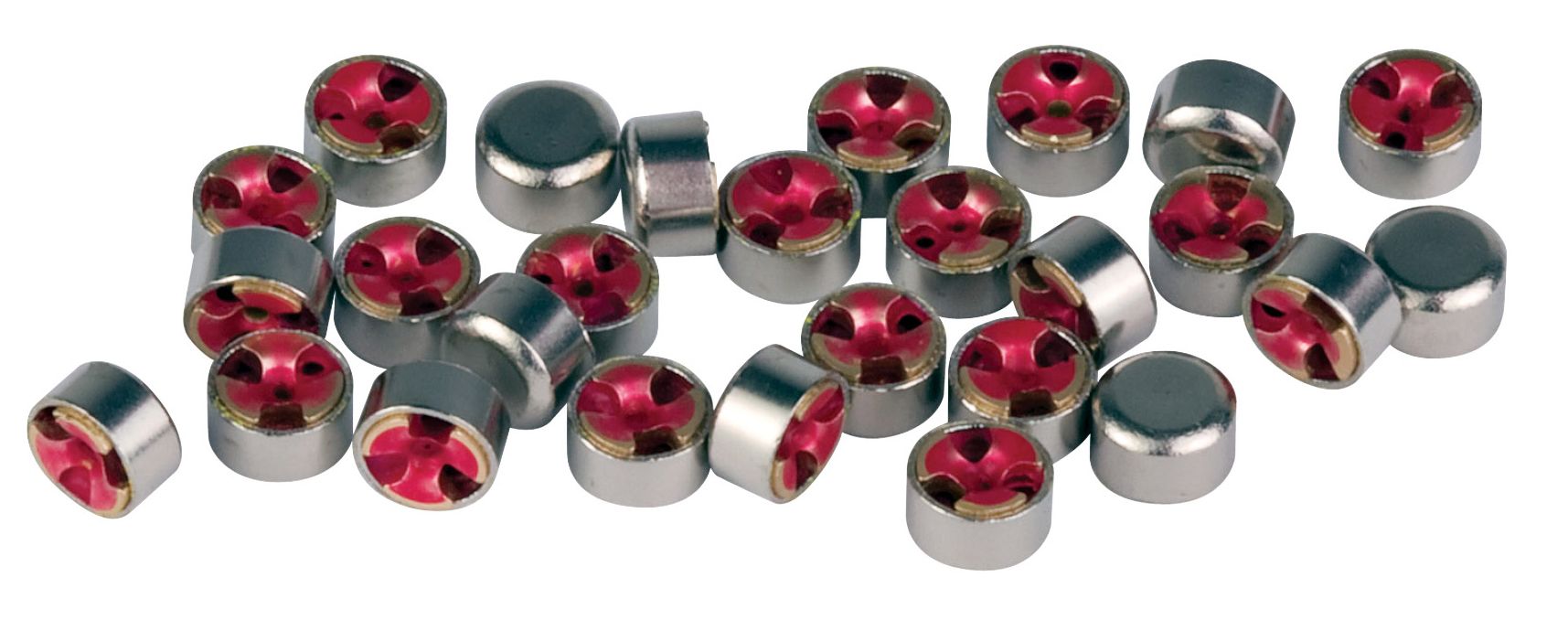
Primer Seating: The insertion of a centerfire primer or battery cup in the head of a cartridge case or shotshell. Properly seated, it should be flush or below the face of the head.
Primer Flash: The illumination produced by the extremely hot gases which result from the very rapid build-up of pressure and temperature when the priming mixture detonates.
Primer Failures: Primer cratering occurs when there’s a circumferential rearward flow of metal surrounding the indentation of a firing-pin in a fired primer cup.
- Primer leak is the escape of gas between the primer cup and head of the cartridge case, or shotshell head.
- Primer setback is a condition when a primer, or battery cup primer assembly, moves partially out of its proper location in the primer pocket of a metallic cartridge or shotshell during firing.
- Primer blank is a fired primer cup in which the firing-pin indent has been punched out by internal gas pressure. A blown primer is separated completely from the cartridge or shotshell after firing due to severe expansion of the primer pocket and head.
- A dropped primer is one that is separated completely from the cartridge or shotshell after firing without obvious distortion of the primer pocket and head.
- A flattened primer is a condition where the normally rounded corners of a fired primer cup are squared due to internal pressures; or a primer cup configuration in which the crown is flattened to alter sensitivity.
- A loose primer is does not fit properly in the primer pocket of a cartridge case or shotshell. A pierced primeris a fired primer which has been perforated by the firing-pin.
Priming Mixture: A combination of explosive and/or pyrotechnic type ingredients, which, when pressed into a cup or spun into the rim cavity of a rimfire shell, will explode or deflagrate from the impact of a firing-pin and ignite the propellant in a cartridge or shotshell.
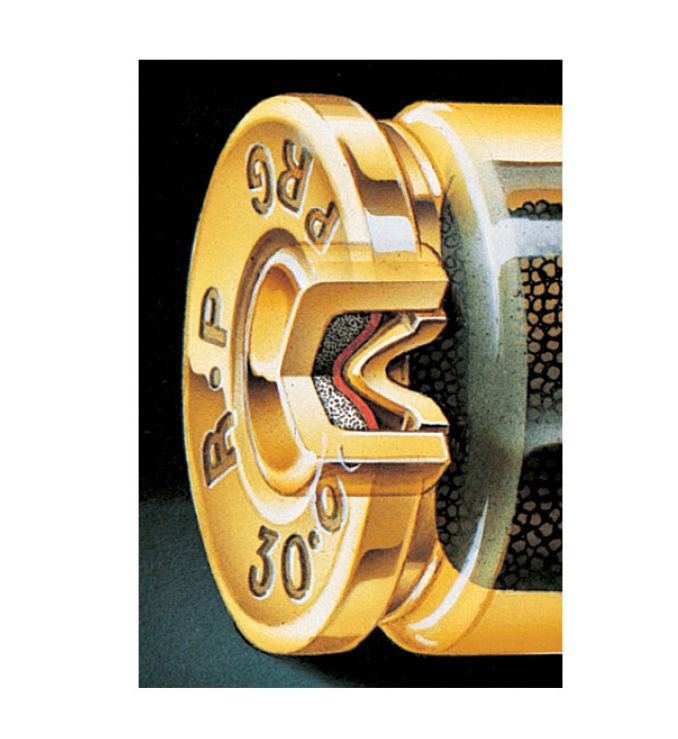
Projectile: An object propelled from a firearm by the force of rapidly burning gases or other means.
Propellant: In a firearm, the chemical composition which, when ignited by a primer, generates gas. The gas propels the projectile. Also called powder, gunpowder, smokeless powder, blackpowder.
R
Reloading: The process of manually reassembling a fired cartridge case with a new primer, propellant and bullet or wads and shot. Also called handloading. Reloading components include primers, propellant powder, bullets, or shot and wads, used with fired cases to load ammunition. Reloading data are descriptions of recommended relationships of reloading components. Reloading dies are tools which hold and/or reform cartridge cases or shotshells during a reloading operation.
Rifling: Grooves formed in the bore of firearm barrel to impart rotary motion to a projectile. Rifling pitch is the distance the projectile must move along a rifled bore to make one revolution. Usually expressed as one turn in x inches (or millimeters).
Rim: The flanged portion of the head of a rimfire cartridge, certain types of centerfire rifle and revolver cartridges and shotshells. The flanged portion is usually larger in diameter than the cartridge or shotshell body diameter and provides a projecting lip for the firearm extractor to engage so that the cartridge or shotshell may be extracted from the chamber after firing. In a rimfire cartridge, the rim provides a cavity into which the priming mixture is charged.
- The rim seat is a counterbore in the rear end of a chamber or bolt face to support the head of a rimmed cartridge.
- A cracked rim is a radial rupture of the head and rim of a rimfire cartridge or shotshell.
- A split rim is a circumferential rupture of the rim of a rimfire cartridge or shotshell.
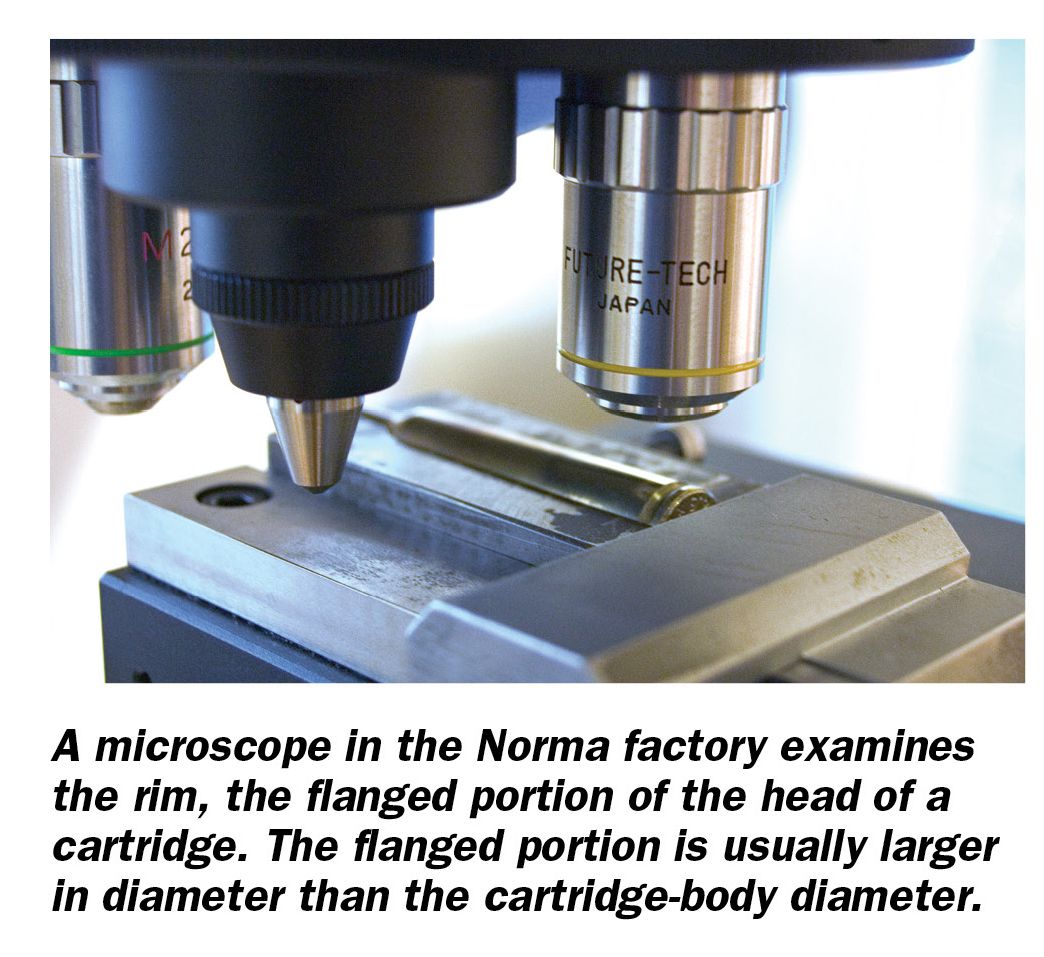
Rupture: A generally circumferential separation in the side wall of a cartridge case. May be complete or partial.
S
SAAMI: The acronym for the Sporting Arms and Ammunition Manufacturer’s Institute.
Sabot: From the French word for shoe. A carrier in which a sub-caliber projectile is centered to permit firing the projectile in a larger bore firearm. In small arms or artillery, a cylindrical projectile of less than bore diameter is encased in a bore diameter sleeve that is discarded in flight after discharge. It is commonly used in large (.50 caliber or greater) diameter military ammunition to provide high-velocity armor defeating capabilities. Also found in shotgun slugs and some other specialized hunting ammunition.
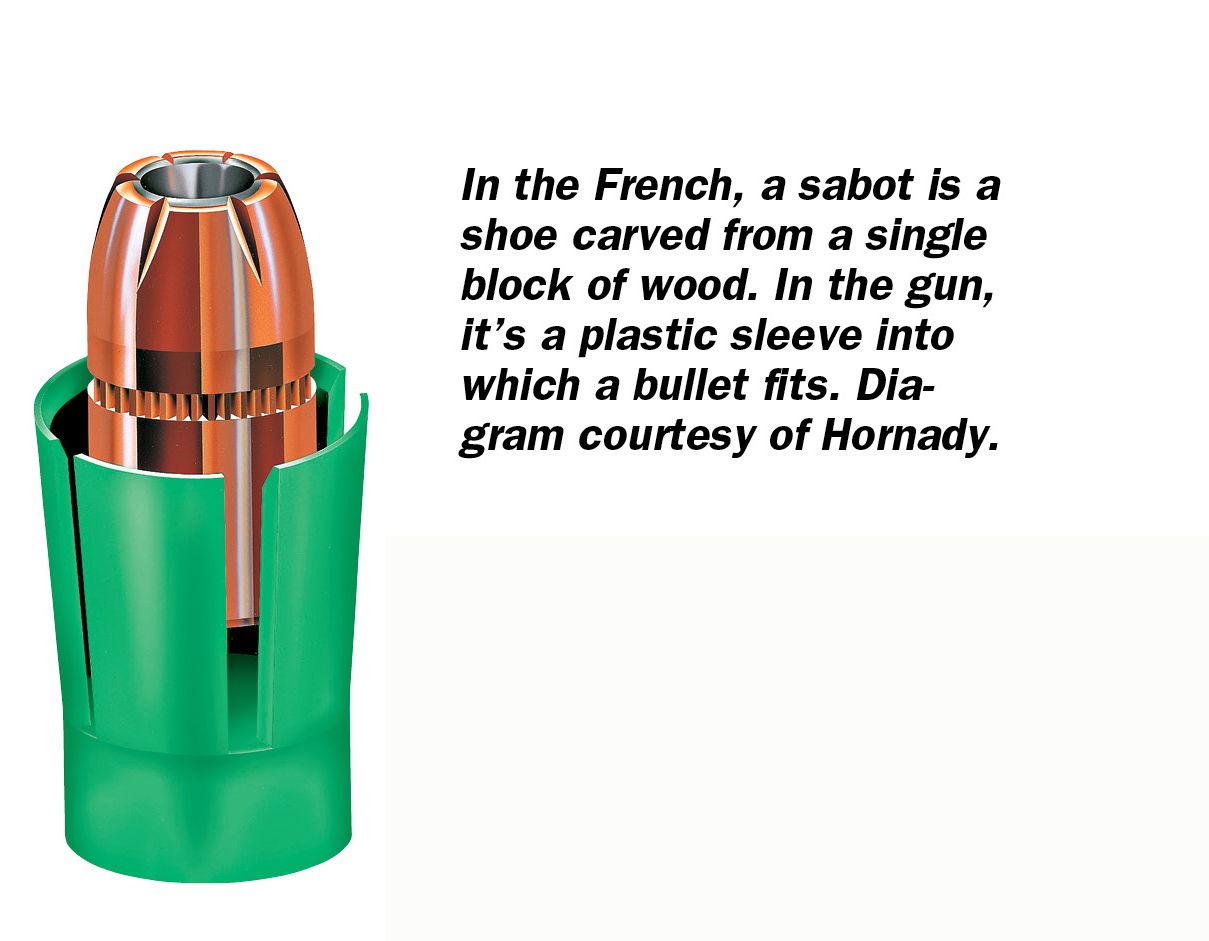
Season Cracking: A term used for stress-corrosion cracking that involves metallic cases or shotshell cups with both residual stress and specific corrosive agents.
Seating: The positioning of a primer or bullet in a metallic cartridge case or a wad in a shotshell. Seating depth is the longitudinal position of a bullet, primer or wad in a cartridge case.
Secant Ogive: A projectile nose with the curvature not tangent to the cylindrical bearing portion.
Sectional Density: The ratio of bullet weight to its diameter.
Shocking Power: A colloquial term used to describe the ability of a projectile to dissipate its kinetic energy effectively in a target.
Shoulder Radius: The curved surface between the body and the shoulder of a cartridge case.
Short: A type of 22 caliber rimfire cartridge.
Short Round: A cartridge in which the bullet is seated below the specified minimum length.
Shot: Spherical pellets used in loading shotshells. Commonly formed from lead but may be made from steel or other heavy metals.
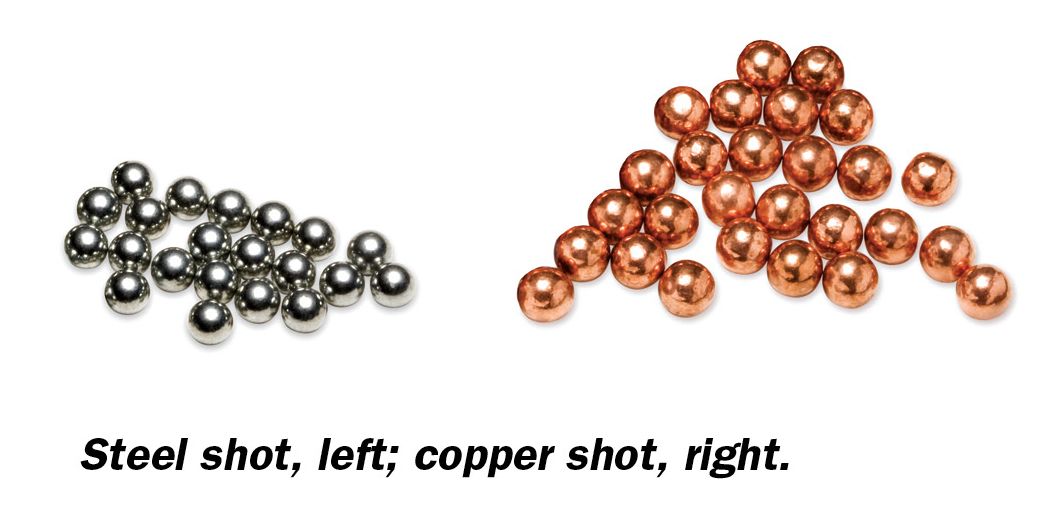
- Drop shot (soft shot) is lead shot containing less than 0.5% alloying metal.
- Chilled shot is lead shot containing more than 0.5% alloying metal to increase its hardness. Also called Hard Shot.
- Coated shot is copper or nickel-plated shot, coated to increase apparent shot hardness and reduce in-bore shot deformation.
- Dust shot is lead shot having a nominal diameter of .040 in. or smaller.
- Fused shot occurs when two or more shot pellets joined together during the process of manufacturing or during firing.
- Steel shot are soft steel pellets made specifically for use in shotshells.
- Bird shot is a general term used to indicate any shot smaller than buckshot, or individual projectiles of less than .24 in. diameter.
Shot Size: A numerical or letter(s) designation indicating the average diameter of a pellet. With numerical designations, the average pellet diameter may be determined as follows: Shot Size = (17 – Number Designation)/100. For example, for No. 6 shot: (17-6)/100 = 0.11 in. The size of the shot is given as a number or letter—with the larger number the smaller the shot size. The size designation was originally based upon the size of a mesh through which the shot would pass. The finest size generally used is #9 which is approximately .08 in. in diameter and the largest common size is #2, which is approximately .15 inch in diameter. However, bird shot is available in a range of sizes from .05 in. (#12, also called dust shot used in .22 rimfire shotshells) to .21 in. (TT). Buckshot has individual projectiles of .24 in. in diameter or greater.
Shot Collar: A plastic or paper insert surrounding the shot charge in a shotshell to reduce distortion of the shot when passing through the barrel.
Shotshell: A round of ammunition containing multiple pellets for use in a shotgun. A one-piece shotshell is a shotshell component having the body and basewad as a single unit with a metallic cup. Sometimes called unibody shell. Also, a complete round of ammunition having the body and basewad as a single unit without a head of a different material. A plastic shotshell is a complete round of ammunition having a plastic body, a basewad that may or may not be a single unit and a metallic head.

Shot Bridging: A wedging action of shot pellets in a tube causing a stoppage of flow in a shotshell loading operation.
Shot Column: The length of the shot load in a shotshell.
Shot String: The distance between the leading and trailing pellets of a shot charge in flight.
Shot Tower: A tall building in which molten lead alloy is dropped through a colander near the top of the tower into a tank of water at the bottom to produce spherical pellets.
Shoulder: The sloping portion of a metallic cartridge case that connects the neck and the body of a bottleneck-type cartridge.
Shoulder Split: A longitudinal rupture in side wall of the shoulder of a bottlenecked cartridge case.
Sizing: The reduction in diameter of a bullet by forcing it through a die of smaller diameter than the bullet. Also, the reduction in diameter of a cartridge case by forcing it into a die of smaller diameter than the case. A sizing die is a tool used to form a cartridge case or bullet to proper dimensions. Full-length sizing is the operation of reforming a fired cartridge case to approximately its original dimensions. Neck sizing is the operation performed by reloaders to reduce or restore the original neck diameter of a fired cartridge.
Skid Marks: Longitudinal rifling marks formed on the bearing surface of bullets as they enter the rifling of the barrel before rotation of the bullet starts.
Slug: A term applied to a single projectile for shotgun shells. Also slang term for bullet. A Brenneke slug is a formed rifled slug with a wad assembly attached to its base by a screw for use in shotguns. A rifled slug is a single projectile with spiral grooves and hollow base, intended for use in shotguns.
Small Arms: Generally a military term. Fully-automatic weapon capable of being carried by a person and fired without additional mechanical support.
Smoothbore: Firearm with unrifled bore, typically a shotgun.
Spire Point: A projectile with a conical nose profile.
Spitzer: A pointed projectile with a profile characterized by a curved ogive and a small flat.
Squib: A cartridge or shell which produces projectile velocity and sound substantially lower than normal. May result in projectile and/or wads remaining in the bore.
Stem (Stemming): A failure of a cartridge to feed in which the bullet jams against the top or bottom of the chamber.
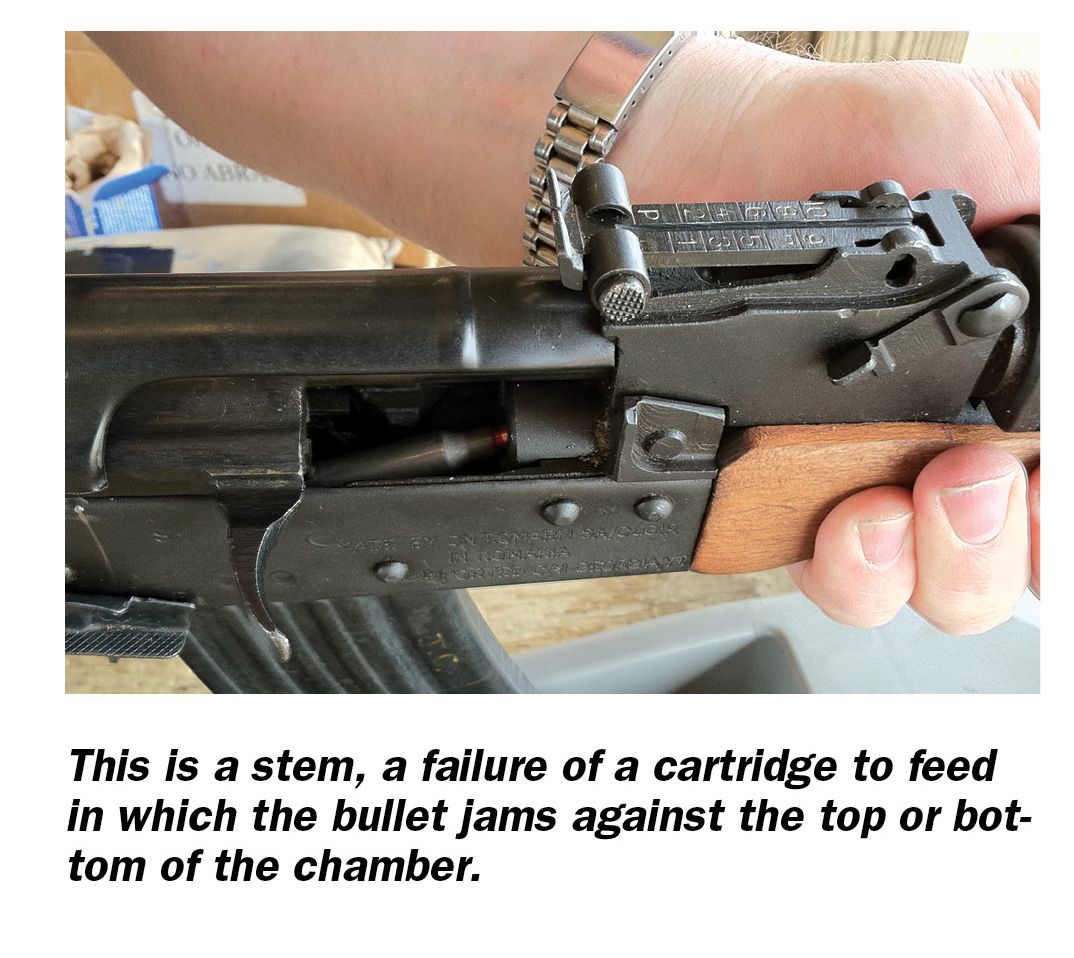
Stoppage: When a firearm stops firing due to a malfunction of either the gun mechanism or ammunition. This term is normally used in connection with automatic firearms, machine guns, etc.
Stopping Power: Inexact, misused term that refers to the ability of a small-arms cartridge to cause a living target to be incapacitated.
Stove-Piping: A failure to eject where the fired case is caught in the ejection port by the forward motion of the bolt The case protruding upward out of the ejection port is said to resemble an old fashioned stove pipe.
Subcaliber Tube: A tube which is placed in the bore of a firearm to enable the firing of smaller or lower powered ammunition.
T U V W X Y Z
Tipping: The instability of a bullet in flight. Keyholing.
Trap: A device to safely stop a bullet in flight. Usually found in indoor ranges behind the target area.
Trajectory: The curved path of a projectile from muzzle to target. A parabolic curve that crosses the line of the sight twice.
- A trajectory table describes the downrange trajectory of a projectile or of shotshell pellets, buckshot or rifled slugs.
- Flat trajectory is a relative term for minimal arching in the flight of a projectile. Generally, the faster the speed of the projectile, the flatter its trajectory.
- Midrange trajectory is the distance, measured in inches, that a projectile travels above the line of sight at a specific point in the trajectory that is half the distance between the firearm and a target.
Twist: The distance required for one complete turn of rifling usually expressed as a ratio, e.g., 1 in 10 inches. Twist gain is barrel rifling in which the rate of twist is faster at the muzzle than at the chamber end.
Velocity: The speed of a projectile at a given point along its trajectory.
Wad: The material between propellant and shot pellets in a specific shotshell.
- The base wad is a cylindrical component that is assembled into the head end of a shotshell.
- A card wad is a thin card-like disc placed over a shot load or powder.
- A cup wad is a powder and shot separator of a shallow cup design which when loaded with lips down acts to help seal powder gases and so protect the rear of the shot column.
- Filler wads are discs of various shapes and thicknesses used to adjust the volume of the contents of a shotshell.
- Nitro wad is an unlubricated, overpowder wad made of cardboard or felt. It is used with smokeless powder. Also called nitro card wad.
- An overpowder wad is a design of separators, made of various materials and used between the propellant powder and the shot pellets.
- A shot-protector wad is made of plastic and designed to reduce pellet deformation during barrel travel.
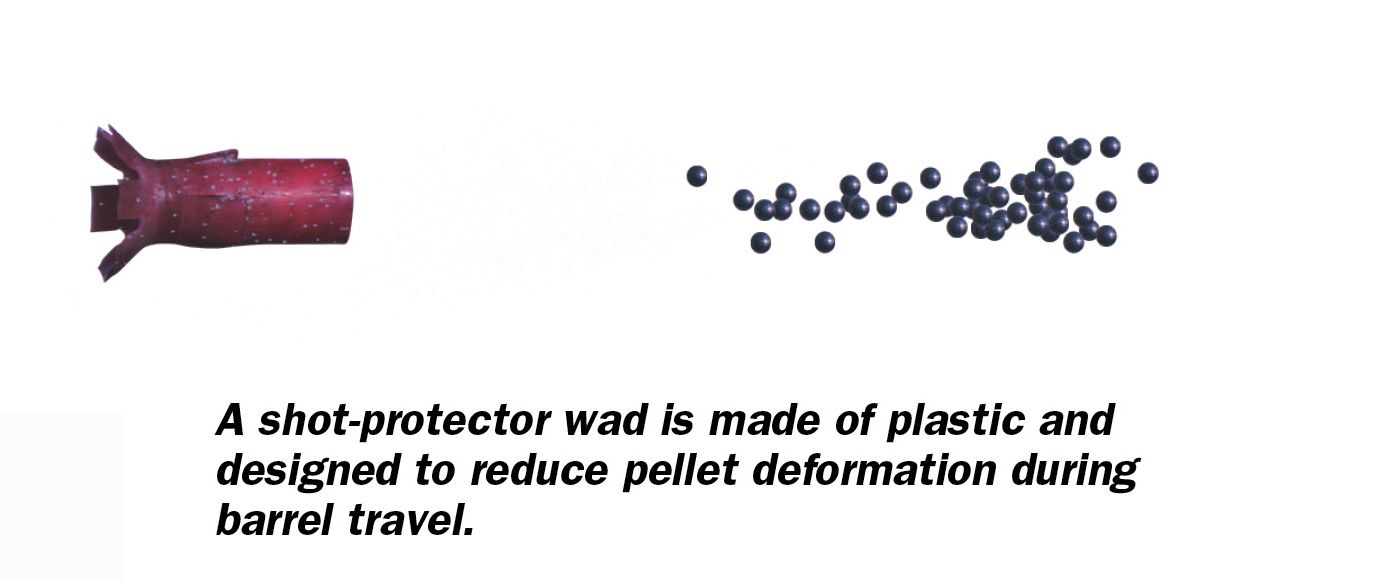
- The top wad is the closure disc over the top of the shot column held in place by a rolled crimp.
Web: The solid portion of a brass centerfire cartridge case between the inside of the case at the head and the bottom of the primer pocket. The smallest dimension of a smokeless powder kernel.
Window Shell: A manufacturer’s sample cartridge with cutaway transparent window to show interior construction.
Wound Trauma Incapacitation: Correct term for the ability of a projectile to incapacitate an animal or human shot with a bullet.
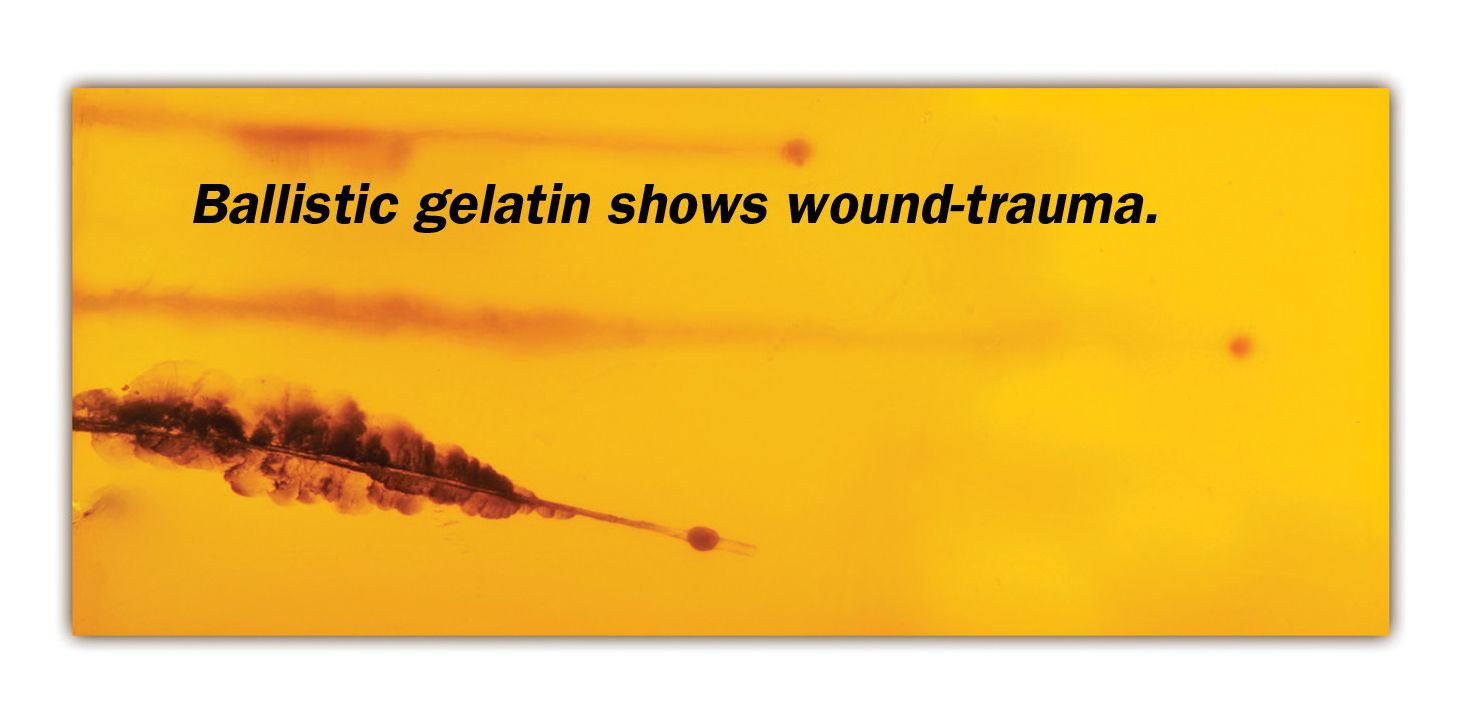
Zero: The farthest distance from a firearm at which the bullet’s path and the point of aim coincide.
